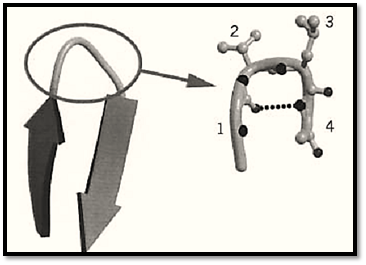


 النبات
النبات
 الحيوان
الحيوان
 الأحياء المجهرية
الأحياء المجهرية
 علم الأمراض
علم الأمراض
 التقانة الإحيائية
التقانة الإحيائية
 التقنية الحيوية المكروبية
التقنية الحيوية المكروبية
 التقنية الحياتية النانوية
التقنية الحياتية النانوية
 علم الأجنة
علم الأجنة
 الأحياء الجزيئي
الأحياء الجزيئي
 علم وظائف الأعضاء
علم وظائف الأعضاء
 الغدد
الغدد
 المضادات الحيوية
المضادات الحيوية|
Read More
Date: 1-1-2016
Date: 16-12-2015
Date: 23-12-2015
|
Beta-Turns
A b-turn is a type of nonregular secondary structure in proteins that causes a change in direction of the polypeptide chain. In the b-turn, a hydrogen bond is formed between the backbone carbonyl oxygen of one residue (i) and the backbone amide NH of the residue three positions further along the chain (i + 3) (Fig. 1) (1). This (i) to (i + 3) interaction distinguishes b-turns from g-turns, which have an (i) to (i + 2) hydrogen bond. There are several different types of b-turns, classified according to the backbone dihedral angles of the two intervening residues, (i + 1) and (i + 2). The type I and II turns are the most common, together accounting for about two-thirds of all b-turns, but they have very different amino acid preferences (2). Type I turns prefer Asn, Asp, or Ser in the (i) position; Asp, Ser, Thr or Pro in (i + 1); Asp, Ser, Asn, or Arg in (i + 2); and Gly, Trp, or Met in (i + 3). In contrast, type II turns have a preference for Pro at position (i + 1), Asn or Gly at position (i + 2) and Gln or Arg at (i + 3) (2). Other b-turn types include type I′ (related to type I by inversion of the sign of the f and y angles of the Ramachandran Plot), II′ (related to type II in the same way), IV, VIa, VIb, and VIII. Types I′ and II′ are almost exclusively found in hairpins; that is, they usually connect two adjacent antiparallel b-strands. The type IV b-turn is a miscellaneous type that includes any (i) to (i + 3) hydrogen-bonded turn in a protein structure where the f and y angles are different (by >40°( from the values that define the other b-turn types (Table 1). Types VIa and VIb have a proline cis-peptide bond at the (i + 2) position; in type VIa the proline adopts a backbone conformation close to that of a-helical residues, whereas in type VIb the proline has a conformation similar to that of residues in a b-strand.

Figure 1. Schematic representations of a b-turn in a protein structure. (Left) The b-turn is shown connecting two b-strands in a hairpin motif. (Right) The detailed atomic structure of the b-turn is shown. Residues are numbered 1 to 4 for (i) to (i + 3). The hydrogen bond between the backbone carbonyl oxygen of residue 1 and the backbone amide nitrogen of residue 4 is shown as a dotted line. This example is a type I b-turn, because the backbone angles for the (i + 1) residue are f = –63° and y = –33°; and for the (i + 2) residue, f is –86° and y = –3°. Oxygen atoms and nitrogen atoms are shown as dark spheres. This figure was generated by Molscript (3) and Raster3D (4, 5).
Table 1. Classification of Beta-Turn Types

References
1.J. S. Richardson (1981) Adv. Protein Chem. 34, 167–339.
2.C. M. Wilmot and J. M. Thornton (1988) J. Mol. Biol. 203, 221–232.
3.P. J. Kraulis (1991) J. Appl. Crystallogr. 24, 946–950.
4.E. A. Merritt and M. E. P. Murphy (1994) Acta Crystallogr. D50, 869–873.
5. D. J. Bacon and W. F. Anderson (1988) J. Mol. Graphics 6, 219–222.



|
|
|
|
تفوقت في الاختبار على الجميع.. فاكهة "خارقة" في عالم التغذية
|
|
|
|
|
|
|
أمين عام أوبك: النفط الخام والغاز الطبيعي "هبة من الله"
|
|
|
|
|
|
|
قسم شؤون المعارف ينظم دورة عن آليات عمل الفهارس الفنية للموسوعات والكتب لملاكاته
|
|
|